Here’s how it started:
The problem was this: back in the very first chapter of Tales from the Triverse, published in September 2021, I’d established that a magic spell had sucked so much energy from the universe that two stars had blinked out in the night sky.
It was a throwaway line meant to invoke a memorable visual, and I didn’t think much of it. I carried on serialising the story. Then, three years later, this happened:
, my OG reader from the Wattpad days, had…made a good point.I wouldn’t have worried, as the prologue chapter was done, the series had moved on and Mike was the only person to have noted this irregularity. Except it kept bothering me, like a stray cat outside the window at night that won’t shut the hell up. And there was a complication: I knew that the spell mentioned in that first chapter was going to come back into the story during the finale. By drawing more attention to it, the awkward deal of the stars vanishing would become more prominent.
Tales from the Triverse is very much fiction, blending sci-fi and magic with crime fiction. We’re talking here about a magic spell. Evidently we’re not dealing in scientific reality. But verisimilitude matters greatly to me. The magic in the story is fuelled by light, which wielders suck from nearby sources — hence a wizard literally draining two entire stars. While the magic might be made-up, the physics of the world are not, and the physics didn’t work.
Here’s the thing: even if Kaenamor, our erstwhile wizard, was sucking the light from a distant star in order to power his spell, the light from that star was still heading towards him. Once he stopped casting the spell, that light would continue to travel from the distant star to the observer’s point of view.
The stars absolutely would not vanish, because light would still be making its millions-of-years journey through space:
I needed an explanation, not only to stop myself from going mad, but also to avoid a potentially widening plot hole that I was barrelling towards. But I couldn’t solve the problem alone. Hence, asking the question over on Substack Notes:
That was back in January of this year.
(if you’re not a Notes user, all you need to know is that it’s a bit like Twitter, a bit like Bluesky, but is populated primarily by writers of all kinds)
I didn’t know what to expect. If I’d posted this on other social media platforms, I doubt I’d have had much of a response. But straight away,
recommended talking to :This was, evidently, very confusing. I’d known John for a while, but didn’t realise there was another John of equal excellence. Summoned, he came:
And it wasn’t just John:
I also received direct messages from
and with offers of assistance.It was at this point that I realised I was going to have to explain my made-up fantasy story in enough detail to a bunch of clever, serious people so that they could then solve my physics blunder for me. Some of them would not be familiar with my writing, after all. It was all rather embarrassing, and it occurred to me for the first time that clever astrophysicists (even if it was a long time ago) could very easily think that I was mad, or that my writing was appalling.
Anyway, I girded my loins and fired off a brief of sorts. It needed to be detailed enough for them to have something to work with, without overloading them with LORE. I wasn’t paying any of these people for their expertise, after all, and I didn’t want to be wasting their time.
I sent each of them this:
Thanks so much for being open to my rambling thoughts about made-up fictional magic. If this turns out to not be your sort of thing then do feel free to quietly withdraw and we'll never speak of this again. :)
It's tricky to know how much detail to go into. But here goes -
In quick summary, then: My serial Tales from the Triverse is a crime procedural set in 1970s London with detectives solving portal-related crimes. 200 years earlier several portals opened, one to a dimension where magic is real.
The magic system requires light as a power source. Solar-powered, if you will. During the day, mages can use ambient light or draw from direct sunlight. At night, they require an artificial light source. Light from a bright full moon on a clear night can be used by a skilled wielder.
The setup of the series is that the portals were opened 200 years earlier by a very powerful and irresponsible mage. He used a spell which was leagues beyond what anyone else had done, thereby punching holes in reality. In the very first chapter, he's shown to be drawing his power from starlight using a series of intensifying mirrors. After the spell is cast, two stars in the sky are no longer visible, suggesting that the mage actually extinguished the distant stars entirely by using up their energy.
Here's where I came a bit unstuck, and why I was hoping to pick the brains of people more clever than me:
At the time of writing, the idea of a spell so powerful that two stars actually ceased to exist was a cool visual. But along the way, a reader queried how the stars could have blinked out of existence: even if the mage had been drawing in all the light from them in that moment, that light would still have had to travel many light years to get to the mage. The star at its source would still presumably be generating light and heat, which would still be travelling across space to reach the observer after the spell ended. In other words, the stars wouldn't have blipped out, which makes for a bit of a mini-plot hole.
If you're especially interested you can read the chapter in questions here: open.substack.com/pub/simonkjones/p/prologue-two-hundred-years-…
And there's some additional info on the magic system here: simonkjones.substack.com/p/bonus-the-nature-of-magic
I've since been toying with the idea that the mage actually reached back through time and took all of the star's emitted light from all points along its timeline. Which helps explain things like a) the extreme difficulty of this particular spell b) the immense power requirements c) why people aren't doing spells of this scale all the time.
I'm very aware that ALL of this is made-up wibbly wobbly fantasy magic. There's still time to back out if it's a bit much for a Saturday. :) My questions I think are:
1. If somebody was drawing power from a star, what would it take for the star to be 'used up' and extinguished from the observer's point of view? I'm now thinking this isn't really 'possible' given the parameters originally presented in the text, as light would still be travelling from the star to the observer.
2. Assuming that this mage could reach back through time to absorb all of the star's energy from its birth, would that cause all sorts of paradox issues? How would that manifest over time? Paradoxically, if he's drawing power from it from all points in time, the star would simultaneously exist and not exist at all points in time. (this is where my brain fails me)
3. If there was a sentient species on a planet orbiting that star, what would they observe? They would need to have evolved on that planet over a long period of time, before the spell was cast, but that may not be possible if the star's power is being stolen from all points along its timeline. Again, seems like a paradox.
To be clear, I'm fine with there being weird paradoxes, but I'm keen to present them in as faux-realistic a manner as possible. Clearly, none of this is Proper Science! But I'm looking for a veneer of verisimilitude that can underpin some of the fantastical goings-on.
Any insights gratefully received, even if it amounts to "this all sounds very, very silly, Simon, please never message me again." Also happy to hop on a video call if that would be easier. Thank you!
Which, in retrospect, feels like way too much detail and general verbosity. Erk.
Then, I waited.
I thought perhaps I would need to leave Substack, possibly leave the entire internet, to avoid the cringiest awkwardness there ever was. What if these kind people all blocked me? What if they called the police? What if—
Fortunately, none of that catastrophising went down. Instead, over the next couple of days, I received detailed, thoughtful responses from each of them, answering my questions, raising new ones and suggesting potential ways forward. Excitingly, a consensus of sorts emerged: a fictional explanation that had its roots in reality, while still being fun and embracing the magical aspects of the story I’m telling.
Many of their suggestions have ended up being paraphrased as lines of dialogue, including in chapters still to come.
It’s hard to properly explain how meaningful it is that a group of people, many of whom I hadn’t known prior, took time out of their days to help me workshop a fiddly story problem. As the detailed replies popped into my inbox, one after another, it felt like a throwback to the early promise of the internet, that at some point we squandered in favour of views and likes and virality. This was me, connecting across the world to highly skilled people in various countries, who were sharing their expertise in order to help me write better fiction. They fully embraced the absurdity of my request, took it seriously, understood the brief perfectly and solved the problem.
As a collaborative exercise in creativity (and, sort of, science communication), it was hugely exciting.
Their insights immediately informed the ‘The Vanishing Star’, a story I was publishing that very month. It goes down in part 3:
The Vanishing Star: part 5
This is my ongoing scifi / fantasy / crime fiction serial. New chapter every week.
The characters Lola and Yana have a conversation in that chapter that is largely born out of my messages with John, Caitriana, Simon, Mark and Arthur. The metatext here is that my characters are identifying and vocalising the plot hole from the very first chapter of the series, and that they need to solve the seeming inconsistency — it’s me turning my own mistake into a new story thread.
I felt quite clever about that. But it’s all thanks to the insights from that wonderful cohort of clever people that reached out on Notes.
Figuring out what was going on drove much of the rest of that season. I’m still constructing the Triverse finale, and the explanation of the vanishing stars continues to serve as a sort of macguffin. It’s not the main thrust of the story (that’s always the characters, and exploring fascism and colliding cultures), but it’s a handy extra motivator.
I’m sure I’ll come back to how these contributions shaped the overall story in a future piece, once all the chapters are out in the wild.
Crucially, this throwaway line in the first chapter from 2021 is no longer a problem:
Sitting down on a pile of rubble, the student rubbed at her eyes, wondering how it could have happened. Shifting her gaze upward, she frowned at a once-familiar constellation. Adding to the strangeness of that evening, she was almost certain that two stars had entirely vanished from the night sky.
You can read the whole thing here, if you’re so inclined:
Prologue: Two Hundred Years Earlier
Hello! Tales from the Triverse is a long-form, weekly serial. It’s primarily a series of science fiction and fantasy detective stories. You can dip in and out of specific storylines or start here and read the whole thing. New chapters come out every Friday.
Meanwhile.
I saw Fantastic Four: First Steps with the boy and enjoyed it immensely. My detailed thoughts are over on Infinite Backlog:
I have one eye on what I’m going to do post-Triverse, and top of the list is a comic. As such, I’ve been practising sketching whenever I can.
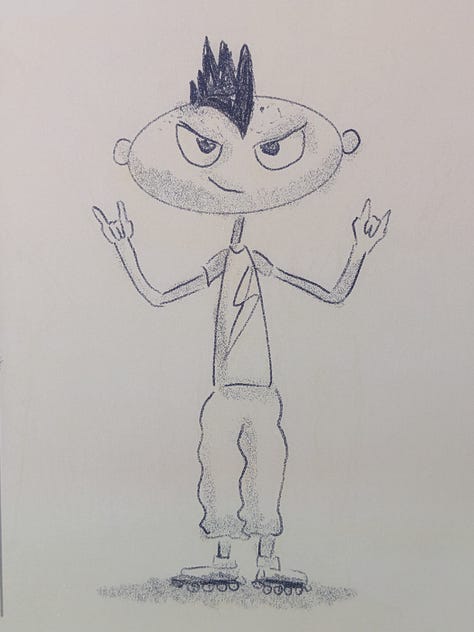
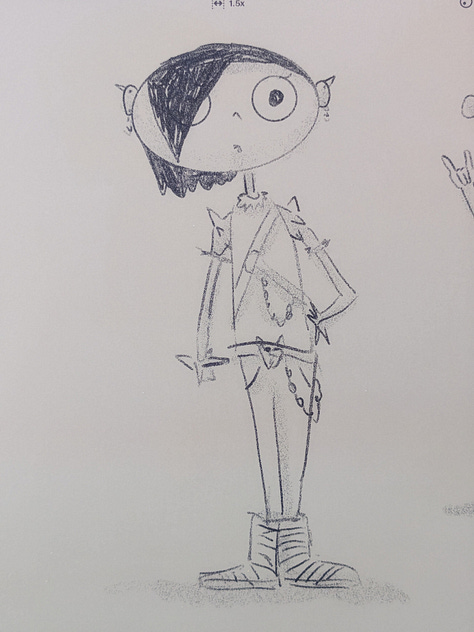

Early days, obviously. And Jeff the Shark is a blatant copy of Gurihiru’s work, when I was experimenting with some new techniques.1 But it feels like I’m getting somewhere: moving away from attempting to draw realistic humans and instead embracing a more cartoon aesthetic. It seems to be working — you’ll have spotted some of these illustrations popping up in Monday newsletters. I can draw Big Head characters that look distinct from one another, which really is all I need to get going with a story.
Elsewhere, last week’s Triverse chapter was set in orbit around Enceladus, one of Saturn’s moons. I was pleasantly surprised to see the moon got a namedrop this month in this article about the European Space Agency’s Juice probe.
Finally, all writers know that when we’re sitting doing absolutely nothing, staring into space, we’re often at our most productive. As such, I enjoyed this piece over on
:See you later in the week for more Triverse.
I had a moment of realisation: Jeff the shark is a circle with some triangles attached and a few bits on the circle erased. So clever! So simple!




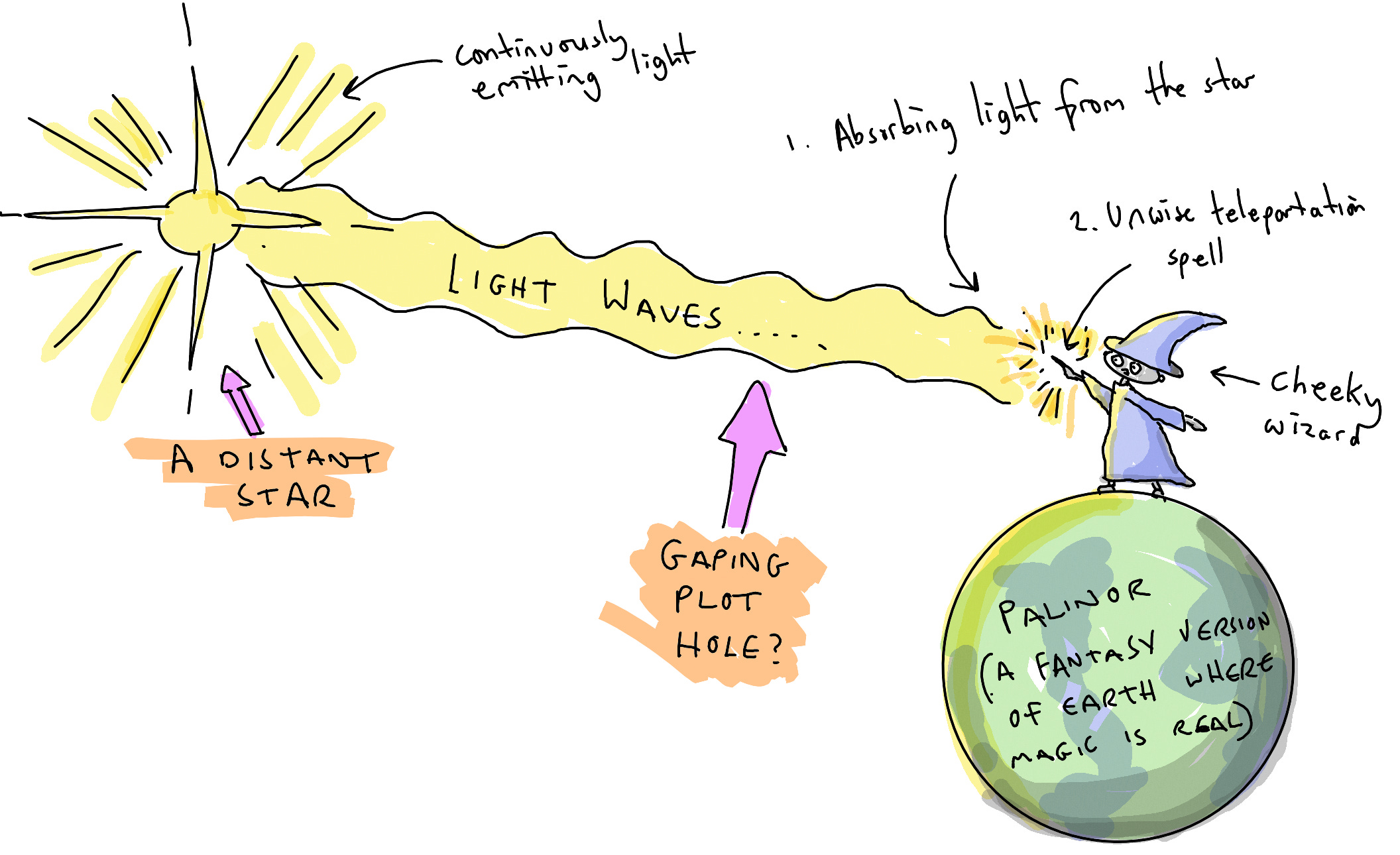
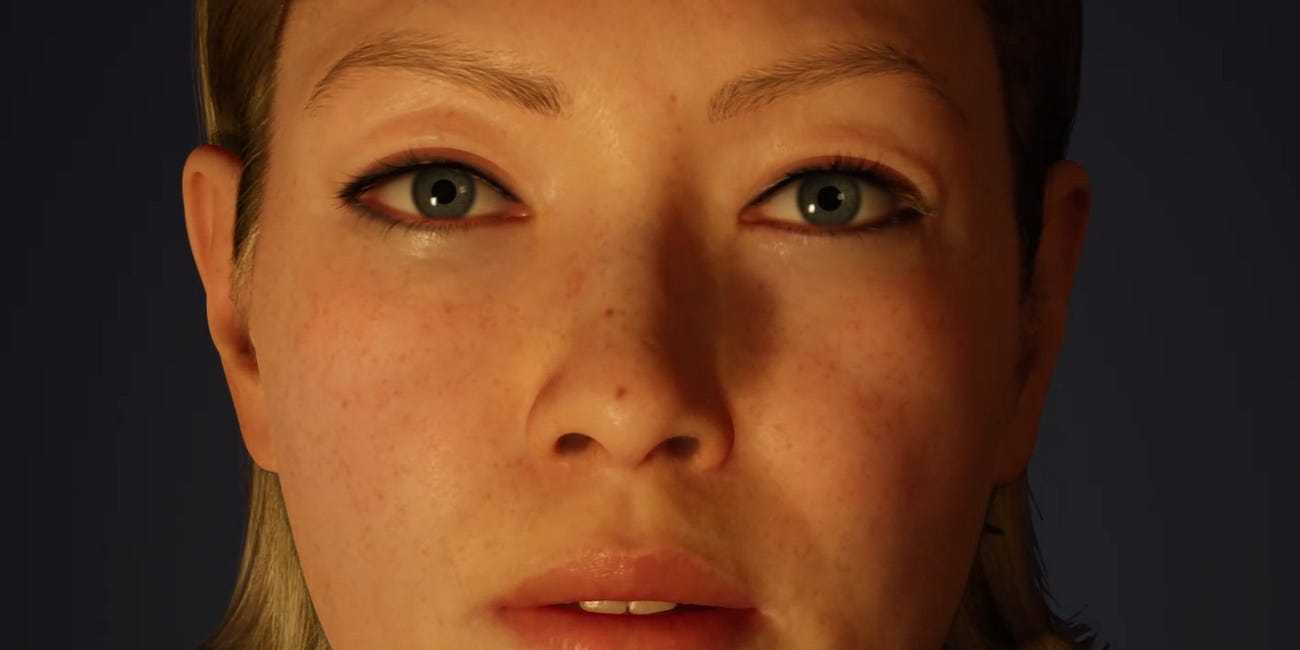
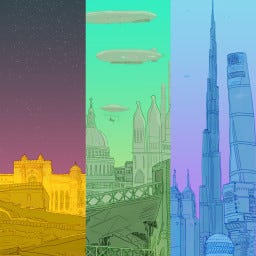


I’m so happy it worked out. There’s nothing better for any writer than to have a wide and disparate network of experts who are happy to chat about their deep knowledge.
I could joke I'm sorry I said anything (and t'was on a THIRD read, when I went, "waitaminute..."), but, eventually, someone else would have the same thought, so at least it came up while you had time to deal with it before reaching the end of the story.
Not a physicist, of course, but, if a temporal shift also occurred, said stars could have been, say, four years away (like Alpha Centauri), not hundreds, thousands, or millions.
Given Einsteinian physics links space and time, and that Kaenamor's spell linked universes (obviously a massive warping of space), a little temporal jiggery-pokery is probably perfectly plausible, but, I'll re-read the relevant linked chapter and see if I can spot what the actual scientists came up with in character dialog.